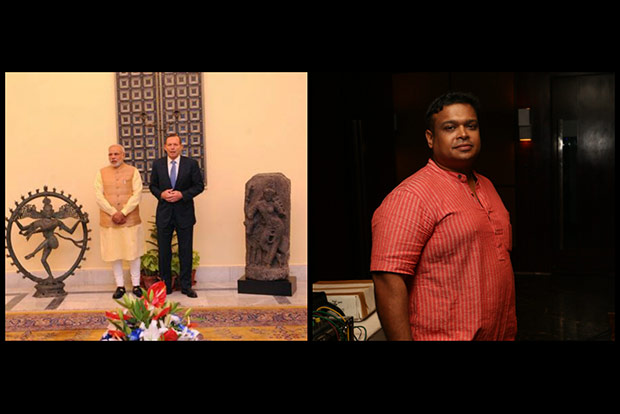Begin typing your search...
Bringing stolen idols back to India
The India Pride Project is a private attempt to make restoration of what is our pride and heritage. S. Vijay Kumar from the Project decodes the art of the ultimate con – and how his work involves making reparation of major dues

Chennai
India’s most celebrated cultural treasures are being stolen at an alarming rate. An estimated 10,00020,000 idols have been trafficked out of the country every decade after 1950 by an elite clique of art smugglers. However, the absence of a national archive or art squad coupled with scant official interest in tracking stolen idols means that antiquities worth millions of dollars are lying in warehouses, museums or art galleries abroad.
S Vijay Kumar is one of many private art investigators behind India Pride Project (which he co-founded), one that has over 200 volunteers and academicians, documenting and archiving our cultural treasures, visiting temples and photographing idols for the records, tracking stolen Indian antiquities and ensuring their return to the country, while wading through miles of bureaucratic red-tape. He was in the city recently to deliver a lecture on the subject, which was organised by Madras Musings.
It’s a steal!
According to him, antiquities looting is being carried out on an industrial scale as he proceeded to describe the modus operandi. “Dealers and auction houses are equipped with research materials on our ancient sites. In some cases, they are even assisted by local experts, who conduct site visits, wherein they identify idols of merit. Or else, local robbers visit sites, take photos and offer it to networks for potential buyers — over email, social media and WhatsApp. The target identified, the price is negotiated and local dealers engage petty thieves to commit the robbery. The thieves initially take a sculpture or two and place them either in safe houses or even drop them off in nearby forests, tanks or ponds. If the theft goes unnoticed, they move in to take away everything from the site,” explained Vijay
For large pieces, local artists are engaged to make replicas. “The thieves offer the replicas to export promotion boards or the Archaeological Survey of India (ASI), to obtain an export license. However, the original is shipped off while the fakes are left in the temple, where unsuspecting devotees offer their prayers. Art dealers operating on a large scale ship the idols out by declaring that they are newly made handicrafts, brass ware and even as garden furniture,” said Vijay, adding that the shipments often end up at intermediary locations like Hong Kong, Bangkok and Singapore, where fake paper work is generated.
“Objects in need of restoration are shipped to professional restorers in London, after which they may be taken to Switzerland. Then, these artworks are brought to Europe or America, as the property of a Swiss collector, further creating a credible provenance, a document establishing place of origin/source. Now, dealers engage art historians to authenticate and write flowery listings for these pieces. In some cases, the objects are offered for temporary exhibitions or long term loans to reputed museums, thus doubling or tripling their value,” he said.

Smuggling hotbed
Vijay revealed that it is not only the temples, which are prime sites for looting ancient idols. “Culturally rich excavation sites, ruins, ASI site museums are also targeted. Basically, the sites which haven’t been documented are preferred by smugglers as they are easier to rob. Freshly excavated items, which, in many cases, go unreported, are also much in demand,” he explained.
Returning antiquities to the country from which they were stolen is an uphill task, according to Vijay. The statistics too paint a gloomy picture. Vijay revealed, “According to the National Crime Records Bureau, 4,408 items were stolen from Indian temples between 2010 and 2012. Only 2,913 idols and antiquities have been traced to museums abroad in the last two decades. According to UNESCO, an estimated 50,000 idols and artefacts had been stolen from India till 1989. The number, apparently, doubled and tripled over the years. In any given decade starting from the 1950s, according to conservative estimates, the number of Indian idols smuggled was between 10,000 to 20,000, valued at about Rs. 20,000 crores.”
The recovery process
The attitude towards restitution efforts is also visible in the number of idols successfully brought back to the country. According to Dr. Mahesh Sharma, Minister of State for Culture and Tourism (Independent Charge), the Archaeological Survey of India has recovered 18 antiquities from various countries till date.
Vijay explained, “Out of this, 50% of the antiquities were from Tamil Nadu. This is because antiquities here are better documented. States like Madhya Pradesh, Orissa, Rajasthan and West Bengal suffer the maximum due to antiquities looting. Restitution was difficult (till 2010) wherein buying countries were insisting on proof/ evidence of theft. But with increasing global awareness of threat posed by the illicit trade in cultural property, focus by UN and UNESCO and role of ISIS in seeking funding from antiquity sales, the perspective has changed.”
Italy and Cambodia – countries known for their rich heritage and culture – are leading players behind the changing attitude towards stolen antiquities. “Their contention has been that the onus of proof should be on the buyer and not source countries. They have also beefed up their art squads, which actively monitor art auctions and sales and are proving to be an effective deterrent,” Vijay added appreciatively. India Pride Project played a key role in the restitution of the Vriddhachalam Ardhanari and Sripuranthan Nataraja from Australia, Sripuranthan Uma from ACM Singapore, the Kashmir Tengupura Durga from Germany, Sripuranthan Ganesha from America and many other precious antiquities.

Lacklustre official response
The official response towards stolen antiquities is dismal in India. Vijay said, “Items, which were seized way back in 2007, have still not made their way home. We expected our efforts will be lauded by Indian officials. But we saw more doors slammed at us.”
Stolen idols are also returned to India in the guise of diplomatic ‘gifts’. The Sripuranthan Nataraja, a bronze sculpture of Lord Shiva was handed over to Indian Prime Minister Narendra Modi in 2014 by Australian Prime Minister Tony Abbott, after it was smuggled out of the country in 2006. Vijay highlighted the role his team played in this restitution. “I spotted the idol at National Gallery of Australia. We sought the assistance of the French Institute in Pondicherry who have extensively documented sites in South India and managed to source a photo when the bronze was still in the temple before the theft in the year 1994. Then, we set out to match the picture and go about looking at the provenance documents. The chain of ownership showed that this idol, dating back to the 11-12th century, was bought by a Sudanese diplomat Abdulla Mehgoub in 1970, from the Fine Art Museum in Delhi. The idol, by descent, went to his wife Raj Mehgoub, who then sold it to Kapoor. The National Gallery of Australia then purchased this Nataraja from Kapoor for USD 5,000,000 in 2008. Armed with irrefutable proof of fake provenance papers evidenced by fake dates, Vijay approached the National Gallery of Australia, who conducted a check of all their antiquities purchased from the same source. They also returned the Vriddhachalam Ardhanari for similar reasons,” said Vijay, who writes about stolen antiquities in his blog, Poetry in Stone.
Punishment remains mild
When arrests are made, the accused are not punished severely enough, said Vijay. He cited the recent case in Chennai, where on May 31, the idol wing of the Tamil Nadu police seized around 250 idols, more than 1,000 years old, from the home of octogenarian smuggler Deenadayalan. “It was known that Deenadayalan supplied Kapoor with antiquities not just from Tamil Nadu, but also from Amravathi and Karnataka. He should have been arrested much earlier, since there was enough evidence against him. Kapoor’s associate, Rajasthan-based art smuggler Vaman Ghiya, who was accused of smuggling around 10,000 pieces outside India, was arrested in 2003, but acquitted in 2013,” Vijay said, with not a single object he trafficked returned.
India has no system in place for the protection of our idols, some of which are more than a thousand years old. He felt that a proper national archive should be set up, using crowd sourcing models. A national art squad under the Ministry of Defence should be formed and public awareness spread. “We are tracking over 2,000 pieces, but only five have been brought back to India. We won’t rest until we bring them back to their rightful abodes,” he said.
Visit news.dtnext.in to explore our interactive epaper!
Download the DT Next app for more exciting features!
Click here for iOS
Click here for Android
Next Story



